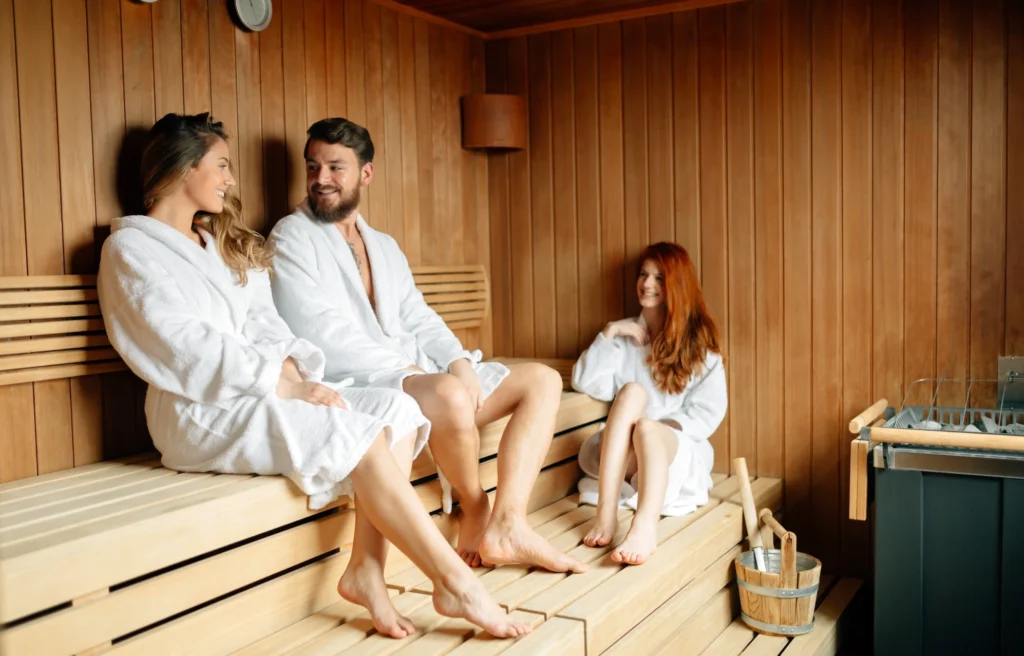At a Global Wellness Institute event discussing the latest research around saunas, mental and social well-being dominated the conversation
Most people choose to sweat it out in saunas for their recovery, stress-relieving and performance perks, but these heat-therapy dens could have the potential for other crucial benefits: improved mental health and community-building.
In a webinar hosted by the Global Wellness Institute, independent researchers and industry professionals came together to discuss the latest science on traditional and infrared saunas, with mental well-being dominating the conversation.
Why Saunas May Help Treat Depression
Last year, Ashley Mason, a clinical psychologist and researcher at the University of California, San Francisco Osher Center for Integrative Health, published a study demonstrating how sauna sessions reduced depression symptoms.
Mason’s team examined how the combination of cognitive behavioral therapy and whole-body hyperthermia (sauna immersion) impacted mental health, specifically major depressive disorder. In the study, participants’ core body temperatures were raised to 101.3 degrees Fahrenheit, which took about 90 minutes to reach.
The integrated mind-body intervention found clinically meaningful reductions in depression symptoms among participants who completed the eight-week treatment; 11 of the 16 participants no longer met criteria for major depressive disorder.
“When you go in a sauna or do some kind of heat therapy, you heat up,” Mason explained. “As soon as you exit the heat, you have a rebound temperature lowering.”
That dip in temperature is what Mason and her team correlated with a dip in depressive symptoms, while targeting the boy’s thermoregulation processes.
“We have largely edited meaningful thermal stress out of our lives,” she added. “We are always the same temperature.”
“People with depression tend to run hotter,” Mason noted. The sauna forces the body to turn on its cooling mechanisms and combat that higher body temperature, in addition to the calming and relaxing atmosphere it creates for the mind.

Infrared vs. Traditional Saunas
In her research, Mason has found that both infrared and traditional saunas are effective. Infrared units use light to generate heat in place of traditional hot coals or wood-fired saunas.
“I think that there is room for all of them in the wellness space,” she said, referring to different kinds of saunas. “And by wellness space, I mean mind and body.”
Infrared saunas can also be appealing financially and practically, according to Dr. Raleigh Duncan, the founder of sauna company Clearlight.
“I find infrared is way more accessible,” Dr. Duncan remarked, noting that infrared saunas can usually be installed and removed in-home fairly quickly, making them easier to incorporate than a full wood-burning sauna.
Communal Sauna Experiences Take Off
As researchers like Mason examine the mental health benefits of saunas, people like Lasse Eriksen, development manager at Norwegian-based hotel Farris Bad, see the community-building potential of these third spaces. In places like Oslo, saunas are a “massively social experience,” he said.
Mason pointed out that research has firmly established that community is one of the top drivers of happiness and overall well-being, leading to a trend of people gravitating to third spaces like gyms, fitness clubs and saunas.
“You leave behind the noise of the day,” Eriksen said. “You connect with yourself and others on a deeper level when you’re in this community space.”
The trend is proving to hold strong for brands like Othership, known for its community-based immersive contrast therapy.
Already a hit in Toronto and New York City, the brand pulled in $8.5 million in funding in July to power its U.S. expansion, including its new 6,500-square-foot Brooklyn facility. Othership plans to keep growing its NYC footprint with an Upper East Side location slotted for 2027.



